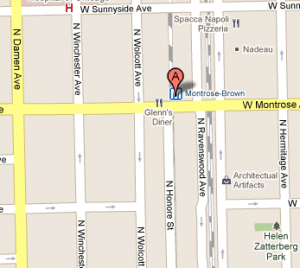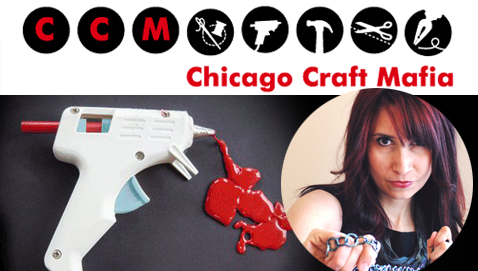Calling all Chicago crafters! Interested in knowing how veteran crafters price their goods? This Wednesday, April 20th come on out to the Chicago Craft Mafia’s Spring Craft Racket and hear from the experts. Step out for an evening of socializing, talking shop, and sharing a snack or two with fellow crafters at Beans & Bagels on Montrose. Make sure to bring one of the products you make/sell, as well as the story behind why you created it. The Mafia will lead an informative exercise to help you see how the value of your work might be seen in the marketplace, and what you can do to ensure you’re getting paid what you’re worth. A few years ago, the Mafia conducted a similar pricing exercise, which Rebeca wrote about in the student newsletter.
CCM CRAFT RACKET – Spring, 2011
Wednesday, April 20, 6-9 pm
 Beans & Bagels
Beans & Bagels
1812 W. Montrose
Chicago IL
Cost: FREE!
Please RSVP by emailing [email protected]
For those of your that can’t make it to the Craft Racket because you, oh say, don’t live in Chicago *wink*…here’s some information on this subject from Rebeca, B3 Ambassador Kat Wisniewksi, and recent “Ask an Artist” contributor, Melissa Banks. Feel free to post additional questions on this subject in the comments section of this post or ask us on our page on facebook.

Rebeca’s advice on pricing your crafts from Blue Buddha’s FAQ section:
http://www.bluebuddhaboutique.com/faq/58_Crafters.php

Kat’s advice on how to price your jewelry
(excerpt from “Ask an Artist: How can I get started selling my chainmaille jewelry?” – for even more advice, read the full article here.)
Pricing is so important to my business because it is the perceived value of my work that indicates how exceptional it really is! I calculate the wholesale price in such a way that I still make a livable profit on each item, even if it’s sold wholesale and not at the higher retail price. The math is relatively simple:
True materials cost + The hourly wage I want to earn + Small % of overhead costs + What will get reinvested in business** (MULTIPLY this total by 2 to get your retail price.)
(**this includes money to buy more materials, packaging, office expenses. If you are a new or a relatively new business then anywhere from 15% to 20% of each item you sell at wholesale rates should be reinvested. If you are a more stable business with more of a steady flow of income than this amount should be higher & could be up to 40%.)

Melissa’s advice on this subject
(“deleted scene” from Melissa’s “Ask an Artist” article – read the original article here)
Always have a formula for pricing your work. Always. Then you will be sure you are paid for your time. With chainmaille, it’s all about labor! And don’t short-change yourself! I started out WAY underpricing my work, even though I did have a formula (this was engrained in school). Then when I realized I needed to increase my prices as my time became more valuable, and even though I am confident in doing so, I always worry about customer response. Best to set your prices correctly to begin with.
This is the simplified version of what I do:
Labor x hourly rate + materials = Wholesale price
Wholesale price x 2.2 = Retail
This is what I’ve read you’re SUPPOSED to do:
Labor x hourly rate + materials + overhead + PROFIT = Wholesale price
So…..when I design a piece, I will make a second one and time it from start to finish, at a normal pace. That’s my labor. Now set your hourly rate. (Using my formula, you have to include overhead and profit into your hourly). I started out giving myself an hourly rate of I think $20? Sounded good to me at the time, but wow – you can’t live on that as an artist! Remember, you’re not getting paid for a 40 hour work week, guaranteed. You might work 80 hours a week but only sell/make money for 20 of those hours, AND you have to run a business (overhead) AND pay yourself a wage. Forget it. So the hourly I give myself is now much higher, but after overhead and how many hours I put in, it’s not nearly my actual wage – who pays me to do paperwork? Oh right – nobody. So you have to try and keep everything in perspective when you consider your formula, and don’t skimp or your overhead and/or lack of profit could be your downfall.
Then….there are some pieces where “perceived value” comes into play, and that’s something you will learn over time. I may make a necklace with a very simple design that I can make very quickly, but am I going to really sell it for $20 according to my formula? No way. I’ll sell it for $60 because that’s what people expect to pay (perceived value), and I still sell a ton of them. That’s just a bonus profit margin, and might make up for other extra costs/expenses. Hint: If people are constantly telling you your prices are too low, then your prices are too low!
* On a side note, I like to mark up 2.2 for retail because many stores don’t like to just double the wholesale price to get their retail price, they mark it up a bit more. This helps keep all pricing consistent as possible, so a customer that sees my work at an art fair, on my website, and at a store will see pretty much the same price! Easy, no confusion, and you want to avoid hearing, ”why is it (this price) here, and (that price) at the other place?” And FYI, the term for doubling a wholesale price to get retail – straight x2 markup – is called “keystoning,” something I didn’t learn for quite a while and would be a good word to keep in your business lexicon.
Also, I cannot stress enough the importance of having both a wholesale and a retail price that will make you a profit! You cannot formulate your prices at retail first and disregard the need or possibility to sell to a brick and mortar store at wholesale, you are working backwards. In fact, that hurts other artists! When I see people selling crafts for $12 it kills me because it brings the selling margin down (#1) and it also becomes very confusing for everybody, most importantly for customers, if they see your work for double the price at a store because the store has to mark it up (#2). So your wholesale and retail price cannot be the same – I see it happen – stop doing it, people! 😉
A good thought to end with would be this: It would be much easier to maybe come down on your prices a bit if your pieces don’t seem to be selling well (not that I’m promoting overpricing your work), than to keep raising them if you find out you are underpricing your work. Best to start with a formula that makes sense that you can stand behind and feel good about – so be confident in the value of your work, and just as important – your time! You’ll find you are going to put in much more time that you realize once the business moves ahead, and bottom line is you have to be compensated for it. Good luck!




Francine, These are great questions. I’m going to pull them aside for a future Ask An Artist article, possibly with myself as the artist.
As a quick answer – I do a little bit of both. I tend to make what I like because, well, if it doesn’t sell, then I can wear it. But I also do a few designs that I do not like one bit, but they sell like hotcakes!